February 21st Scots Book of Days
February 21 1304 Sometime in February. Battle of Happrew 1304.
1437 – King James II Stewart begins reign. When his father James I (b. 1394) dies at Friars Preachers Monastery in Perth, stabbed and murdered by Sir Robert Graham. James 1st attempted to escape his assassins through a sewer. However, three days previously, he had had the other end of the drain blocked up because of its connection to the tennis court outside, balls habitually got lost in it.
1491 Janet or Joanna Douglas, before February 1481, (d. before 21 February 1491) wife of Patrick Hepburn, 3rd Lord Hailes, 1st Earl of Bothwell. And daughter of James Douglas, 1st Earl of Morton by his spouse, Princess Joanna Stewart.
 Hepburn Motto: KEEP TRYST. Crest: A horse’s head couped Argent, bridled Gules.
Hepburn Motto: KEEP TRYST. Crest: A horse’s head couped Argent, bridled Gules.
1507 James Stuart, Duke of Rothesay born Holyrood Palace, Edinburgh. Dies 1508.
1525 The Imperial commanders, running low on supplies and mistakenly believing that the French forces were more numerous than their own, decided to launch an attack on Mirabello Castle in order to save face and demoralize the French sufficiently to ensure a safe withdrawal.
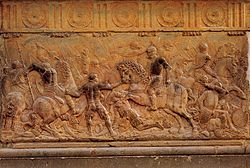 Battle of Pavia by Juan de Orea.
Battle of Pavia by Juan de Orea.
1599 never happened in Scotland. Dating its years from the birth of Jesus Christ, so that ‘’ every nation, kindred, every ear shall hear, every knee shall bow, and every tongue shall confess, Jesus Christ is Lord,’’ thru computer software applications and aviation, the Christian calendar has been adopted world wide for the Musselmen of Islam, the Buddhist, Confucian, Hindu, nativist, Jew, agnostic, or atheist (Isaiah 45:23, 1 Kings 19:18, Philippians 2:11, Romans 14:11, confirmed in modern times Mosiah 16:1 27:31 Doctrine and Covenants 76:110, 88:104
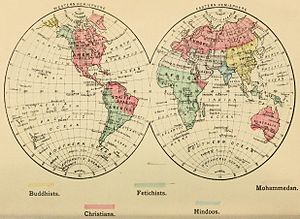 An 1883 map of the world divided into colors representing “Christians, Buddhists, Hindoos, Mohammedans, Fetichists”.
An 1883 map of the world divided into colors representing “Christians, Buddhists, Hindoos, Mohammedans, Fetichists”.
1751 did not occur in England, Ireland, British North America, and British colonies, as 1751 only had 282 days due to the Calendar Act of 1750. But 21 February 1751 did occur in Scotland, as 1751 had 365 days in Scotland. One theory comes from project member, Dr Christopher Gaffney, Archeological Science at the University of Bradford:
“For pre-historic hunter-gatherer communities, knowing what food resources were available at different times of the year was crucial to survival. These communities relied on hunting migrating animals and the consequences of missing these events were potential starvation. They needed to carefully note the seasons to be prepared for when that food resource passed through, so from this perspective, our interpretation of this site as a seasonal calendar makes sense.”
Read more at: http://phys.org/news/2013-07-scotland-lunar-calendar-stone-age-rethink.html#jCp
[Comment on the theory. Scotland is the size of Connecticut, and quite small to have migrating animals. From where would they come? and where would the migrating herds go? Where, from the Firth of Tay to the Firth of Forth? Or Clydesdale to inverness? Migration is not an answer to an interest in seasons. Starvation is not the only incentive, and probably not a good incentive, to observe the heavens and take an interest in science? Or times and seasons, which was the name of the The Church of Jesus Christ of Latter-day Saints’ newspaper on the frontier.]
1741 Jethro Tull (born 1674 Berkshire) died. British Agricultural Revolution. He perfected a horse-drawn seed drill in 1701 that economically sowed the seeds in neat rows, and later a horse-drawn hoe. Namesake for The progressive rock band Jethro Tull. His Printer bookseller was Andrew Millar VI (clans Stewart, Lockhart, Hunter).
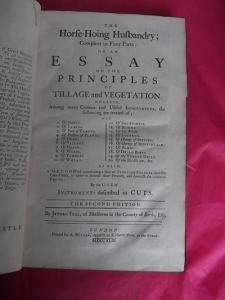 THE HORSE-HOING HUSBANDRY; Compleat in Four Parts: or, an ESSAYS ON THE PRINCIPLES OF TILLAGE AND VEGETATION with A SUPPLEMENT etc. London Printed for A. Millar, opposite the Katherine Street in the Strand. MDCCXLIII.
THE HORSE-HOING HUSBANDRY; Compleat in Four Parts: or, an ESSAYS ON THE PRINCIPLES OF TILLAGE AND VEGETATION with A SUPPLEMENT etc. London Printed for A. Millar, opposite the Katherine Street in the Strand. MDCCXLIII.
1816 Jedediah Morgan Grant (February 21, 1816 – December 1, 1856) was a leader and an apostle of The Church of Jesus Christ of Latter-day Saints. Known for his fiery speeches during the Reformation of 1856, earned the nickname, “Brigham’s Sledgehammer”. Father of Heber J. Grant. Son of Joshua Grant and Athalia Howard Grant. (Grant clan).
1876 also sometime that year. Hortense McDuck was born in 1876 in Glasgow, Scotland as the youngest duckling of Fergus McDuck and Downy O’Drake.


 In 1885 The fictional Clan McDuck’s hereditary lands were in danger of being seized due to her father being unable to pay taxes. The lands also included Dismal Downs, the Clan’s castle which had been abandoned since 1675. The Whiskervilles, traditional enemies of the McDucks since the 15th century, planned to gain ownership of the lands. Nine-year-old Hortense offered to help them and proved more effective in conflict than either of the elder McDucks. One of her proudest moments was when she singlehandedly caused the entire United States Military to flee Killmotor Hill, armed only with a broom, and her bad temper, much to the shame of then current president, Theodore Roosevelt. Fictional clan McDuck.
In 1885 The fictional Clan McDuck’s hereditary lands were in danger of being seized due to her father being unable to pay taxes. The lands also included Dismal Downs, the Clan’s castle which had been abandoned since 1675. The Whiskervilles, traditional enemies of the McDucks since the 15th century, planned to gain ownership of the lands. Nine-year-old Hortense offered to help them and proved more effective in conflict than either of the elder McDucks. One of her proudest moments was when she singlehandedly caused the entire United States Military to flee Killmotor Hill, armed only with a broom, and her bad temper, much to the shame of then current president, Theodore Roosevelt. Fictional clan McDuck.
1878 – The first telephone book is issued in New Haven, Connecticut. The inventor of the telephone, Alexander Bell was born in Edinburgh, Scotland on March 3, 1847, traveled to Boston in 1871, and moved from harmonic telegraph, to phoautograph to acoustic telegraphy, filed for a patent on February 14, 1876 and received patent 174,465, on March 7, 1876 for the telephone. Within two years, enough phones are in place to have a phone book. New Haven is the home of Yale College.
1886 Thomas Hesketh Douglas Blair Cochrane, born. 13th Earl of Dundonald 13th Lord Cochrane of Paisley and Ochiltrie (1935-1958) (21 February 1886 – died 23 May 1958) was an officer in the British Army who served in World War I.
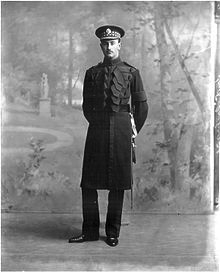 Cochrane was captain in the Scots Guards and fought in World War I, serving on the General Staff. For his services in the war he was awarded the Order of the Merit of Chile and made a Grand Officer, Order por Servicios Distinguidos de Peru. Obit sans posteritie. [Died without descendants.]
Cochrane was captain in the Scots Guards and fought in World War I, serving on the General Staff. For his services in the war he was awarded the Order of the Merit of Chile and made a Grand Officer, Order por Servicios Distinguidos de Peru. Obit sans posteritie. [Died without descendants.]
1900 Astronomer Royal for Scotland was the title of the director of the Royal Observatory, Edinburgh until 1995. Charles Piazzi Smyth FRSE FRS FRAS FRSSA (3 January 1819 – 21 February 1900), was Astronomer Royal for Scotland from 1846 to 1888, well-known for many innovations in astronomy and his pyramidological and metrological studies of the Great Pyramid of Giza. Smyth was born in Naples, Italy to Captain (later Admiral) William Henry Smyth and his wife Annarella. Smyth was called Piazzi after his godfather, the Italian astronomer Giuseppe Piazzi. At the Cape of Good Hope, where he observed Halley’s comet and the Great Comet of 1843, and took an active part in the verification and extension of Nicolas Louis de Lacaille’s arc of the meridian. In 1853, Smyth was responsible for installing the time ball on top of Nelson’s Monument in Edinburgh to give a time signal to the ships at Edinburgh’s port of Leith.
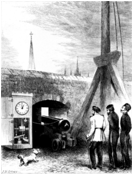 By 1861, this visual signal was augmented by firing the One O’Clock Gun at Edinburgh Castle.
By 1861, this visual signal was augmented by firing the One O’Clock Gun at Edinburgh Castle.
FRSE Fellow of the Royal Society of Edinburgh
FRS Fellow of the Royal Society
FRAS Fellow of the Royal Astronomical Society
FRSSA Fellow of the Royal Scottish Society of Arts
Disclaimer:
Utah Standard News depends on the support of readers like you.
Good Journalism requires time, expertise, passion and money. We know you appreciate the coverage here. Please help us to continue as an alternative news website by becoming a subscriber or making a donation. To learn more about our subscription options or make a donation, click here.
To Advertise on UtahStandardNews.com, please contact us at: ed@utahstandardnews.com.



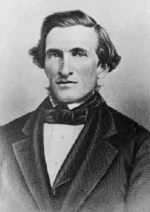

Comments - No Responses to “February 21st Scots Book of Days”
Sure is empty down here...